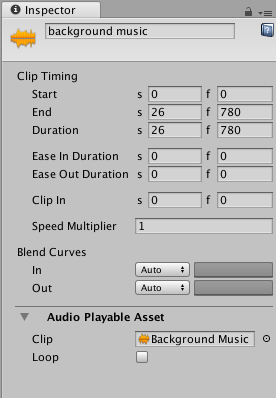Audio Clip properties
Use the InspectorA Unity window that displays information about the currently selected GameObject, Asset or Project Settings, alowing you to inspect and edit the values. More info
See in Glossary window to change the properties of an Audio clipA container for audio data in Unity. Unity supports mono, stereo and multichannel audio assets (up to eight channels). Unity can import .aif, .wav, .mp3, and .ogg audio file format, and .xm, .mod, .it, and .s3m tracker module formats. More info
See in Glossary. These properties include the name of the clip, its timing, play speed, its blend properties, the audio file used by the Audio clip, and whether Audio clip loops or plays once.

Display Name
The name of the Audio clip shown in the TimelineGeneric term within Unity that refers to all features, windows, editors, and components related to creating, modifying, or reusing cut-scenes, cinematics, and game-play sequences. More info
See in Glossary Editor window. This is not the name of the audio file that is used for the waveform. The name of the audio file is part of the Audio Playable AssetAny media or data that can be used in your game or Project. An asset may come from a file created outside of Unity, such as a 3D model, an audio file or an image. You can also create some asset types in Unity, such as an Animator Controller, an Audio Mixer or a Render Texture. More info
See in Glossary properties.
Clip Timing properties
Use the Clip Timing properties to trim and change the duration of the Audio clip. Most of the timing properties are expressed in both seconds (s) and frames (f). When specifying seconds to modify a Clip Timing property, all decimal values are accepted. When specifying frames, only integer values are accepted. For example, if you attempt to enter 12.5 in a frames (f) field, it is set to 12 frames.
| Property: | Function: |
|---|---|
| Start | The frame or time (in seconds) when the clip starts. Changing the Start property changes the position of the clip on its track in the Timeline AssetRefers to the tracks, clips, and recorded animation that comprise a cinematic, cut-scene, game-play sequence, or other effect created with the Timeline Editor window. A Timeline Asset does not include bindings to the GameObjects animated by the Timeline Asset. The bindings to scene GameObjects are stored in the Timeline instance. The Timeline Asset is Project-based. More info See in Glossary. Changing the Start may also affect the Duration. All clips use the Start property. |
| End | The frame or time (in seconds) when the clip ends. Changing the End property affects the Duration. All clips use the End property. |
| Duration | The duration of the clip in frames or seconds. Changing the Duration property also affects the End property. All clips use the Duration property. |
Blend Curves
Use the Blend Curves to customize the transition between the out-going clipThe first clip in a blend between two clips. The first clip, the out-going clip, transitions to the second clip, the incoming clip. More info
See in Glossary and the incoming clipThe second clip in a blend between two clips. The first clip, the out-going clip, transitions to the second clip, the incoming clip. More info
See in Glossary when blending between two Audio clips. See Blending clips for details on how to blend clips and how to customize blend curves.
When easing-in or easing-out clips, the Blend Curves allow you to customize the curve that eases-in an Audio clip and the curve that eases-out an Audio clip. See Easing-in and Easing-out clips for details.
Audio Playable Asset properties
Use the Audio Playable Asset properties to select the Audio file used by the Audio clip and to set whether the selected Audio clip loops (Loop enabled) or plays once (Loop disabled).
- 2017–12–07 Page published with limited editorial review